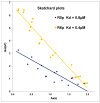Substitution Arg140Gly in Hemagglutinin Reduced the Virulence of Highly Pathogenic Avian Influenza Virus H7N1
- PMID: 34452449
- PMCID: PMC8402889
- DOI: 10.3390/v13081584
Substitution Arg140Gly in Hemagglutinin Reduced the Virulence of Highly Pathogenic Avian Influenza Virus H7N1
Abstract
The H7 subtype of avian influenza viruses (AIV) stands out among other AIV. The H7 viruses circulate in ducks, poultry and equines and have repeatedly caused outbreaks of disease in humans. The laboratory strain A/chicken/Rostock/R0p/1934 (H7N1) (R0p), which was previously derived from the highly pathogenic strain A/FPV/Rostock/1934 (H7N1), was studied in this work to ascertain its biological property, genome stability and virulent changing mechanism. Several virus variants were obtained by serial passages in the chicken lungs. After 10 passages of this virus through the chicken lungs we obtained a much more pathogenic variant than the starting R0p. The study of intermediate passages showed a sharp increase in pathogenicity between the fifth and sixth passage. By cloning these variants, a pair of strains (R5p and R6p) was obtained, and the complete genomes of these strains were sequenced. Single amino acid substitution was revealed, namely reversion Gly140Arg in HA1. This amino acid is located at the head part of the hemagglutinin, adjacent to the receptor-binding site. In addition to the increased pathogenicity in chicken and mice, R6p differs from R5p in the shape of foci in cell culture and an increased affinity for a negatively charged receptor analogue, while maintaining a pattern of receptor-binding specificity and the pH of conformational change of HA.
Keywords: highly pathogenic avian influenza viruses; pathogenicity factors.
Conflict of interest statement
The authors declare no conflict of interest.
Figures







Similar articles
-
Evidence for Different Virulence Determinants and Host Response after Infection of Turkeys and Chickens with Highly Pathogenic H7N1 Avian Influenza Virus.J Virol. 2022 Sep 14;96(17):e0099422. doi: 10.1128/jvi.00994-22. Epub 2022 Aug 22. J Virol. 2022. PMID: 35993736 Free PMC article.
-
A Unique Multibasic Proteolytic Cleavage Site and Three Mutations in the HA2 Domain Confer High Virulence of H7N1 Avian Influenza Virus in Chickens.J Virol. 2015 Oct 21;90(1):400-11. doi: 10.1128/JVI.02082-15. Print 2016 Jan 1. J Virol. 2015. PMID: 26491158 Free PMC article.
-
Adaptive amino acid substitutions enhance the virulence of a reassortant H7N1 avian influenza virus isolated from wild waterfowl in mice.Virology. 2015 Feb;476:233-239. doi: 10.1016/j.virol.2014.11.031. Epub 2014 Dec 30. Virology. 2015. PMID: 25555151
-
Mammalian pathogenicity and transmissibility of low pathogenic avian influenza H7N1 and H7N3 viruses isolated from North America in 2018.Emerg Microbes Infect. 2020 Dec;9(1):1037-1045. doi: 10.1080/22221751.2020.1764396. Emerg Microbes Infect. 2020. PMID: 32449503 Free PMC article.
-
The NS segment of H5N1 avian influenza viruses (AIV) enhances the virulence of an H7N1 AIV in chickens.Vet Res. 2014 Jan 25;45(1):7. doi: 10.1186/1297-9716-45-7. Vet Res. 2014. PMID: 24460592 Free PMC article.
Cited by
-
A Combination of Membrane Filtration and Raman-Active DNA Ligand Greatly Enhances Sensitivity of SERS-Based Aptasensors for Influenza A Virus.Front Chem. 2022 Jun 30;10:937180. doi: 10.3389/fchem.2022.937180. eCollection 2022. Front Chem. 2022. PMID: 35844641 Free PMC article.
-
Basic and Applied Sciences: Technology and Immunobiological Products.Her Russ Acad Sci. 2022;92(4):452-455. doi: 10.1134/S101933162204013X. Epub 2022 Sep 6. Her Russ Acad Sci. 2022. PMID: 36091846 Free PMC article.
References
-
- Webster R.G. Influenza virus: Transmission between species and relevance to emergence of the next human pandemic. Arch. Virol. Suppl. 1997;13:105–113. - PubMed
-
- Gambaryan A.S., Matrosovich T.Y., Philipp J., Munster V.J., Fouchier R.A., Cattoli G., Capua I., Krauss S.L., Webster R.G., Banks J., et al. Receptor-binding profiles of H7 subtype influenza viruses in different host species. J. Virol. 2012;86:4370–4379. doi: 10.1128/JVI.06959-11. - DOI - PMC - PubMed
-
- Scheibner D., Ulrich R., Fatola O.I., Graaf A., Gischke M., Salaheldin A.H., Harder T.C., Veits J., Mettenleiter T.C., Abdelwhab E.M. Variable impact of the hemagglutinin polybasic cleavage site on virulence and pathogenesis of avian influenza H7N7 virus in chickens, turkeys and ducks. Sci. Rep. 2019;9:11556. doi: 10.1038/s41598-019-47938-3. - DOI - PMC - PubMed
Publication types
MeSH terms
Substances
LinkOut - more resources
Full Text Sources
Research Materials

